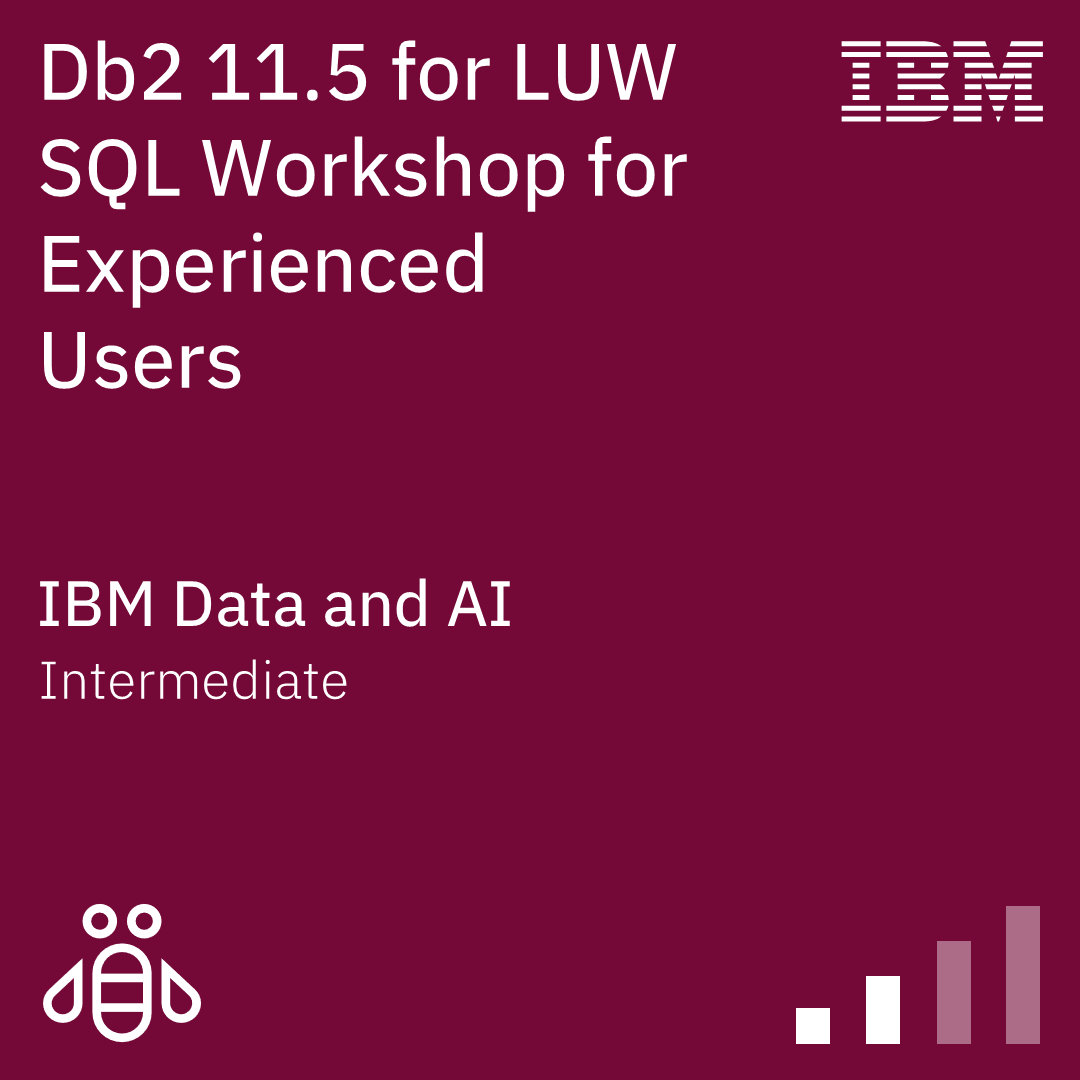title
Please take a moment to fill out this form. We will get back to you as soon as possible.
All fields marked with an asterisk (*) are mandatory.
Db2 11.5 for LUW: SQL Workshop for Experienced Users
Course Description
Overview
This course teaches how to make use of advanced SQL techniques. This course utilizes IBM Data Studio on a Windows 11 operating system, but the SQL queries are appropriate for Linux, UNIX, and Windows environments.
Along with a review of some basic relational database concepts, this course covers some of the OLAP features of Db2, including GROUP and RANK functions. Learners will explore coding joins, using the CASE expressions, the CAST function, and code advance SQL constructs, such as recursive SQL and table expressions.
Learners will also participate in hands-on exercises to practice writing complex queries and subqueries.
Objectives
After completing this course, learners should be able to:
- Discuss basic relational database concepts
- Use some of the OLAP features of DB2, such as GROUP and RANK functions
- Code outer joins and join tables to themselves
- Use CASE expressions and the CAST function
- Write complex subqueries
- Code advanced SQL constructs, such as recursive SQL and table expressions
Audience
This course is intended for individuals seeking to make use of SQL techniques to access Db2 databases in different environments. This course is appropriate for customers working in Db2 environments for Linux, UNIX, and Windows.
Prerequisites
- Be able to discuss basic Relational Database concepts
- Be able to code basic SQL statements
- Have completed the SQL Workshop course (CL722G or 2L722G)
Before taking this course, participants should:
OR
Topics
Unit 1: SQL Introduction
- Identify the purpose of the clauses in the SELECT statement
- Describe the key differences among the IBM Db2 platforms
- Describe and use some of the OLAP features of Db2 such as GROUPING functions like CUBE and ROLLUP, and the RANK, DEFENSE_RANK, and ROW_NUMBER functions
Unit 2: Create Objects
- Code statements to:
- Create tables and views
- Alter tables
- Create indexes
- Implement referential integrity (RI)
- Define triggers and check constraints
- Identify impacts and advantages of referential integrity, including impacts of delete rules
- Identify considerations when using triggers and check constraints
- Identify the advantages of views
Unit 3: JOIN
- Use inner and outer joins to retrieve data from more than one table
- Use joins of tables to themselves
Unit 4: CASE, CAST, Summary (Materialized Query) Tables, and Temporary Tables
- Identify when CASE expressions can be useful
- Code CASE expressions in the SELECT list and in the WHERE clause
- Identify when CAST specifications can be used
- Identify the advantages of using Summary (Materialized Query) Tables and Temporary tables
Unit 5: Using Subqueries
- Code subqueries using the ALL, ANY / SOME, and EXISTS keywords
- Code correlated subqueries
- Choose the proper type of subquery to use in each case
Unit 6: Scalar Functions
- Extend your knowledge of scalar functions which:
- Manipulate arithmetic data
- Manipulate date values
- Manipulate character data
Unit 7: Table Expressions and Recursive SQL
- Identify reasons for table expressions and recursive SQL
- Use nested and common table expressions
- Identify the difference between views and table expressions
- Code recursive SQL
- Control the depth of recursion when coding recursive SQL
Unit 8: An Introduction to UDTs / UDFs and Stored Procedures
- Describe the concepts behind User-Defined District Types, User-Defined Functions, and Stored Procedures
Unit 9: SQL and Db2 Performance
- Explain some basic principles of Db2 performance
- Code SQL statements to obtain better performance
Recognition
When you complete the Instructor-Led version of this course, you will be eligible to earn a Training Badge that can be displayed on your website, business cards, and social media channels to demonstrate your mastery of the skills you learned here.
Learn more about our Application Developers Badge Program →Related Courses
-
Mastering IBM AIX: Advanced Administration and Problem Determination
AN15G- Duration: 40 Hours
- Delivery Format: Classroom Training, Online Training
- Price: 4,475.00 USD
-
Db2 12 for z/OS Basic Database Administration
CV844G- Duration: 24 Hours
- Delivery Format: Classroom Training, Online Training
- Price: 2,685.00 USD
Self-Paced Training Info
Learn at your own pace with anytime, anywhere training
- Same in-demand topics as instructor-led public and private classes.
- Standalone learning or supplemental reinforcement.
- e-Learning content varies by course and technology.
- View the Self-Paced version of this outline and what is included in the SPVC course.
- Learn more about e-Learning
Course Added To Shopping Cart
bla
bla
bla
bla
bla
bla
Self-Paced Training Terms & Conditions
Exam Terms & Conditions
Sorry, there are no classes that meet your criteria.
Please contact us to schedule a class.

STOP! Before You Leave
Save 0% on this course!
Take advantage of our online-only offer & save 0% on any course !
Promo Code skip0 will be applied to your registration
Purchase Information
title
Please take a moment to fill out this form. We will get back to you as soon as possible.
All fields marked with an asterisk (*) are mandatory.










